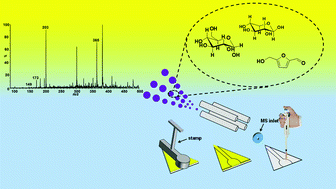A new insert sample approach to paper spray mass spectrometry: a paper substrate with paraffin barriers†
Abstract
The analytical performance for paper spray (PS) using a new insert sample approach based on paper with paraffin barriers (PS-PB) is presented. The paraffin barrier is made using a simple, fast and cheap method based on the stamping of paraffin onto a paper surface. Typical operation conditions of paper spray such as the solvent volume applied on the paper surface, and the paper substrate type are evaluated. A paper substrate with paraffin barriers shows better performance on analysis of a range of typical analytes when compared to the conventional PS-MS using normal paper (PS-NP) and PS-MS using paper with two rounded corners (PS-RC). PS-PB was applied to detect sugars and their inhibitors in sugarcane bagasse liquors from a second generation ethanol process. Moreover, the PS-PB proved to be excellent, showing results for the quantification of glucose in hydrolysis liquors with excellent linearity (R2 = 0.99), limits of detection (2.77 mmol L−1) and quantification (9.27 mmol L−1). The results are better than for PS-NP and PS-RC. The PS-PB was also excellent in performance when compared with the HPLC-UV method for glucose quantification on hydrolysis of liquor samples.



 Please wait while we load your content...
Please wait while we load your content...